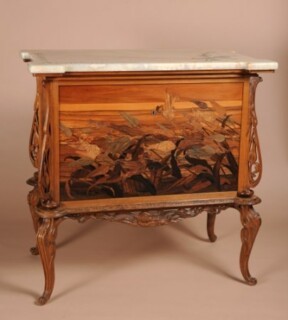In Nancy
Gillian Darley
An elaborate veneered late 19th-century commode is smothered in fecund art nouveau vegetation: according to the inscription on the top, Prunus armeniaca. This is botanical illustration in fine inlay but also a subtle vehicle for political commentary: 100,000 Armenians were massacred by Ottoman forces between 1894 and 1896.
The commode – entitled Le champ de sang – was made by Emile Gallé, one of the leading figures, along with Victor Prouvé, of the Ecole de Nancy, a widely admired and commercially successful group of artists, craftsmen and architects based in what was, after the Prussian annexation of Lorraine in 1871, the most easterly town in France. An excellent exhibition at the Musée des Beaux-Arts in Nancy demonstrates that Gallé and Prouvé were caught up in the political and social anxieties of the moment – above all, the loss of Lorraine.
They produced ‘assiettes parlantes’ which carried such messages as ‘On chant mieux quand on est libre’ and ‘fidèle a son nid fidèle a son pays’. Prouvé had anarchist sympathies; Gallé was drawn to the Irish Republican cause. A key Ecole de Nancy exhibit at the World Fair of 1900 was Gallé’s enormous Amphore du Roi Salomon, with Judaic ornament and an unmistakable Dreyfusard message. If art nouveau has the air of the boudoir, L’Ecole de Nancy provided a strong corrective.
Since 1889 Nancy had supported a Popular University (one of the movements driven by the Dreyfus Affair) and many of the artists, including Prouvé and Gallé, lectured there. The university moved to its permanent home in Paul Charbonnier’s Maison du Peuple in the early 1900s.
Early 20th-century architecture in Nancy is full of symbolism: ironwork thistles (denoting Lorraine) encrust balconies and doors, and the Croix de Lorraine is everywhere. The naturalistic vernacular of art nouveau had uses far beyond the merely decorative.
What began in the 1880s did not dissipate. Jean Prouvé, one of Victor’s sons, started his career as a blacksmith in Nancy but went on to design and produce school furniture, prefabricated housing and barracks. After the Second World War, during which he was active in the Resistance, he was briefly mayor of Nancy, and designed emergency refugee housing. And he was later president of the competition jury that chose Piano and Rogers to design the Pompidou Centre, in its own way envisaged as another ‘house of the people’.
